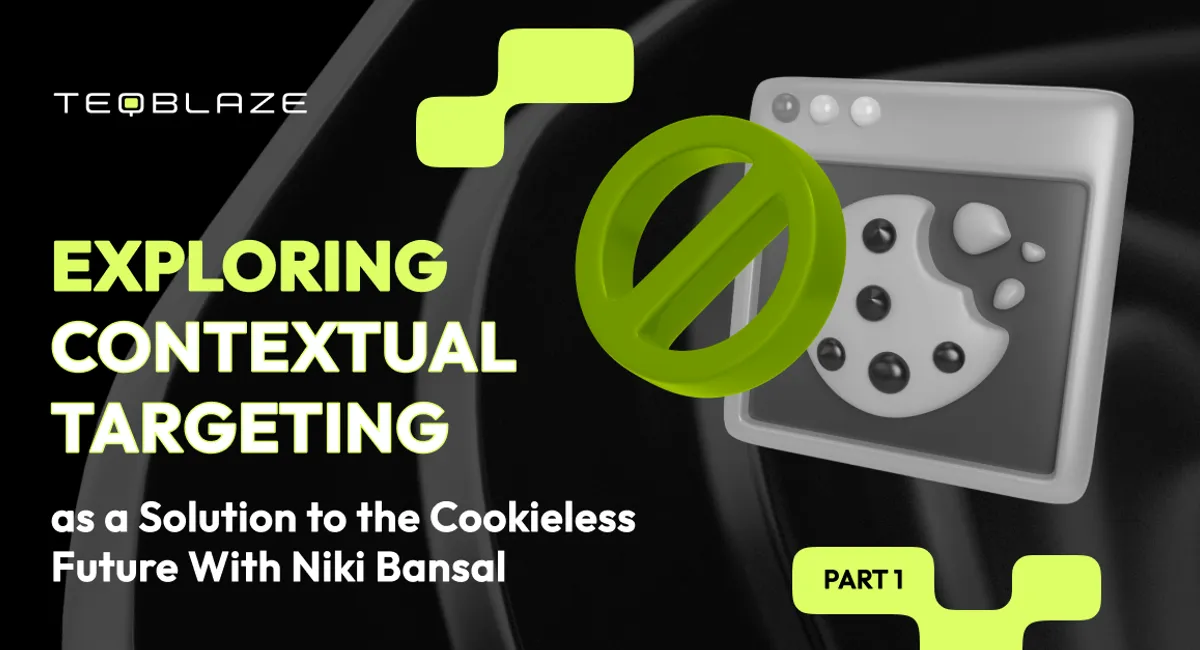With the impending demise of third-party cookies, advertisers are looking for alternative ways to reach their target audiences. Contextual targeting is one such solution that involves targeting ads to users based on the content they are viewing on a web page rather than their browsing history or personal data.
In this first part of our interview cycle with Niki Bansal, CEO at TeqBlaze and ex-Director of Enterprise Solutions at SmartyAds, we will explore the potential of contextual targeting in the cookieless world of digital advertising.
With over a decade of experience in the ad tech industry, Niki is well-positioned to share her insights on the latest trends, challenges, and opportunities facing the industry. We will delve into the benefits and limitations of contextual targeting and discuss how the TeqBlaze Team is helping its clients adapt to this new era of advertising.
So buckle up and get ready to learn about the evolving landscape of ad tech and contextual targeting in this informative interview with Niki.
***
Let's get started. First, can you explain what a cookieless world means for ad tech?
Niki: Sure. Cookies are small files that websites store on a user's device to track their activity and preferences. Advertisers use them to target and personalize ads for users. However, cookies have become less effective in recent years due to privacy concerns and the increasing use of ad blockers. In addition, many web browsers are phasing out support for third-party cookies, so advertisers must find new ways to track and target users.
A cookieless world means that the traditional way of targeting users through cookies will no longer be viable. Advertisers will have to adapt to a new environment where they have limited access to user data and have to rely on alternative targeting methods.
That sounds like a significant change. How are advertisers and ad tech companies adapting to this new reality?
Niki: They are exploring different ways to target users in a cookieless world. One of the most popular approaches is contextual targeting, where ads are shown based on the content of the website or app that the user is currently browsing.
Another approach is to use first-party data, which a website collects directly from its users. This can include user preferences, purchase history, and location data. Advertisers can use this data to target ads more effectively and provide a better user experience.
In addition, some adtech companies are developing new technologies that can track users without cookies. These include methods such as device fingerprinting, which uses a combination of browser settings, screen resolution, and installed fonts to identify users.
Can you tell us why contextual targeting has become such a big trend in adtech?
Niki: It helps advertisers reach their target audience more effectively by placing their ads in front of people who are already interested in their products or services.
That's interesting. What are its benefits over cookie-based targeting?
Niki: Unlike cookie-based targeting, which relies on tracking user behavior across multiple websites, contextual targeting is based on the current web page the user is on, so it doesn't rely on personal data or third-party cookies. It means that contextual targeting is more privacy-friendly than cookie-based targeting. As user data becomes more protected, advertisers can still reach relevant audiences without relying on personal data.
And how does contextual targeting differ from other methods like behavioral or demographic targeting?
Niki: Behavioral targeting uses data about a user's browsing history and online activity to show them relevant ads. Demographic targeting, on the other hand, focuses on characteristics like age, gender, income, and location. While both of these targeting methods can be effective, they do not consider the content of the webpage that the user is currently on.
In contrast, contextual targeting focuses on the context of the content that a user is consuming rather than their personal browsing history. This means that advertisers can target users based on the topic of the content they are viewing rather than their interests and behaviors. Contextual targeting can be a highly effective way of reaching users interested in a specific topic or product, even if they have not previously been interested.
What challenges do you think advertisers will face when implementing contextual targeting in their campaigns?
Niki: One of the biggest challenges advertisers will face when implementing contextual targeting is ensuring their ads are placed on appropriate websites. With contextual targeting, there is a risk that the ad might be displayed on a webpage that is not relevant or appropriate for its product or service. Advertisers must work closely with their adtech partners to ensure their ads are placed on relevant websites that align with their brand values and messaging. Additionally, advertisers need to constantly monitor and optimize their campaigns to ensure that their ads are being displayed in the most effective way possible.
That's a great point. Can you tell us how SmartyAds is adapting to the cookieless era and incorporating contextual targeting into its platform?
Niki: At TeqBlaze, we're prioritizing contextual targeting as a crucial solution for the cookieless era, and we're investing significantly in its development. Our proprietary technology enables real-time page content analysis, allowing us to deliver relevant ads to users without relying on cookies or personal data. We have already conducted successful testing and are currently working on integrating Open AI and supporting the IAB Category Taxonomy for enhanced contextual targeting capabilities.
Additionally, we're also exploring alternative methods of audience targeting that allow us to continue to deliver relevant ads to users while protecting their privacy and complying with regulations.
How do you see this technology evolving in the future?
Niki: Contextual targeting will continue to evolve and become more sophisticated. As technology advances, we will see more accurate and effective targeting based on the context of the content. For example, we may see the use of real-time sentiment analysis to identify the mood of a user as they are viewing a webpage, which could be used to serve more personalized and engaging ads.
We may also see contextual targeting in new areas, such as audio advertising or smart home devices. As these technologies become more prevalent, there will be opportunities for advertisers.
Lastly, what advice would you give to advertisers looking to implement contextual targeting in their campaigns?
Niki: My advice would be to work with a trusted adtech partner who can quickly adapt their functionality and develop a version of contextual targeting that aligns with your specific advertisements and publishers. By collaborating closely with a partner who understands your unique needs, you can ensure your contextual targeting strategy is tailored to your campaign goals and audience, resulting in more effective and relevant ad placements.
Finally, don't be afraid to experiment with different targeting methods to find the one that works best for your business. Contextual targeting is just one of many tools in the advertiser's toolkit, and it's essential to use the right tool for the work.

 Kate Pavlova
Kate Pavlova





